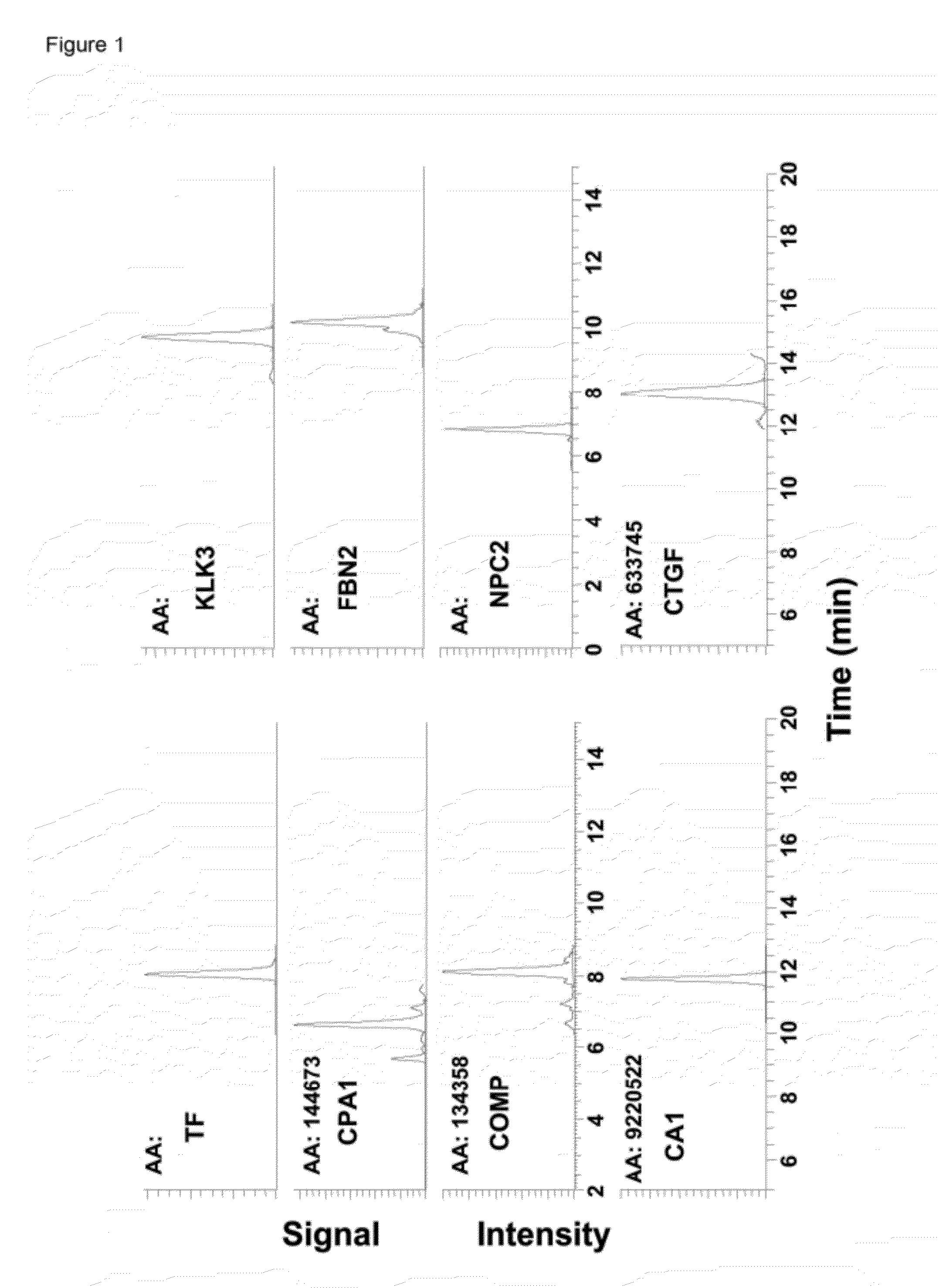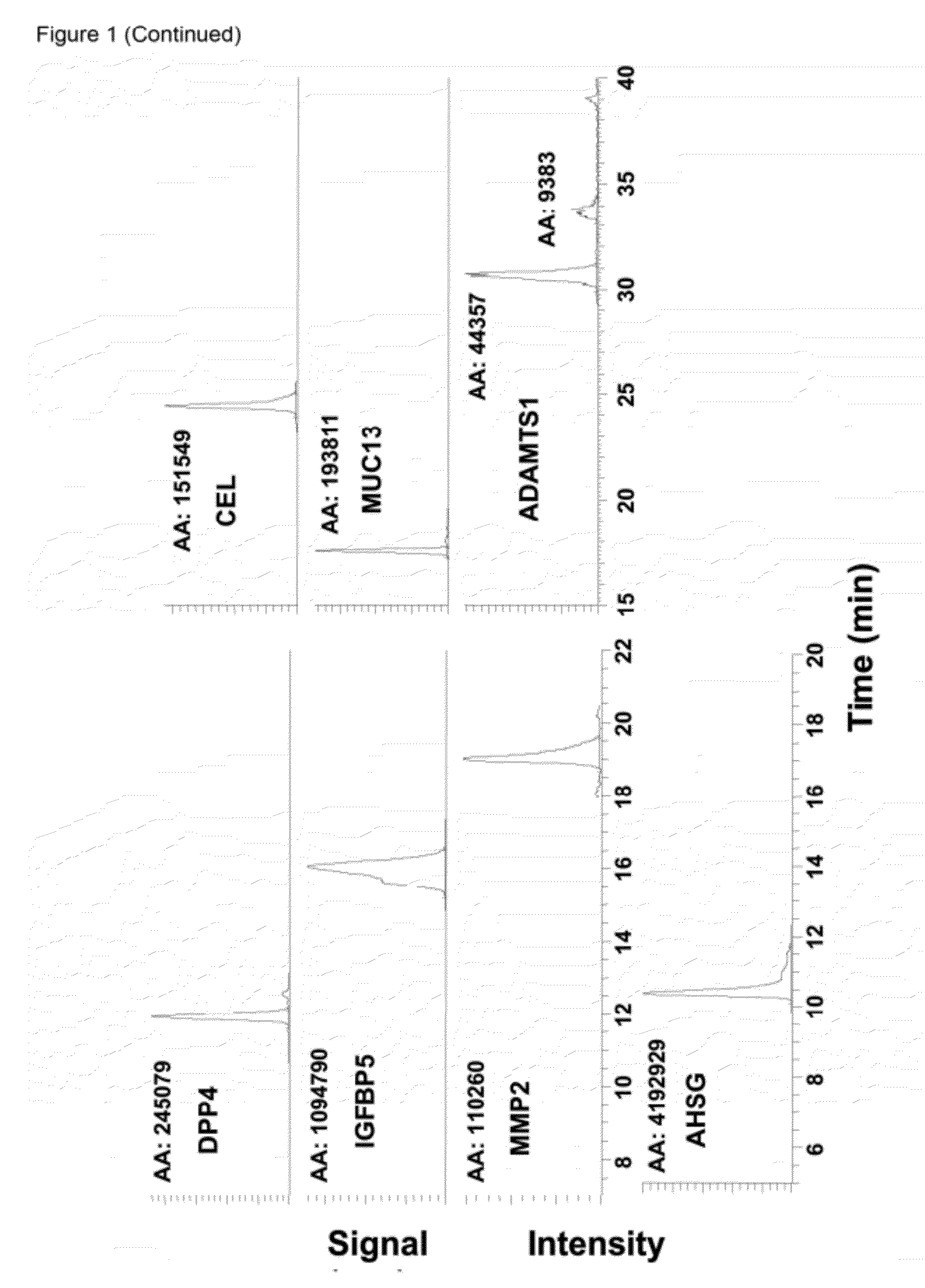Biomarkers for the detection and screening of down syndrome
a biomarker and down syndrome technology, applied in the field of prenatal screening for down syndrome, can solve the problems of large number of false positives, low specificity of screening markers currently available, and unsatisfactory results
- Summary
- Abstract
- Description
- Claims
- Application Information
AI Technical Summary
Benefits of technology
Problems solved by technology
Method used
Image
Examples
example 1
[0164]Prenatal screening test for Down syndrome (DS) can be improved by discovery of novel biomarkers. A multiplex Selected Reaction Monitoring (SRM) assay was developed to test previously identified thirteen candidate proteins in amniotic fluid (AF). One unique peptide was selected for each protein based on discovery data, while three MS / MS transitions were selected based on intelligent SRM results. For one of the candidates, matrix metalloproteinase-2 (MMP2), ELISA was also performed to validate SRM results in AF and to test serum samples. Comparison of AF samples from DS versus controls via SRM assay revealed five proteins that were differentially expressed. Bile salt-activated lipase, mucin-13, carboxypeptidase A1, and dipeptidyl peptidase 4 showed a decrease in DS-affected AF, and MMP2 showed an increase, in comparison to controls (P<0.05). Discovery-based spectral counting ratios and SRM ratios showed a strong correlation, and MMP2 ELISA further confirmed the validity of the S...
example 2
[0189]Amniotic fluid (AF) is rich in proteins which may reflect the well-being of the fetus. It has been hypothesized herein that biomarkers for trisomy 21 exist in AF. A detailed comparison of AF from trisomy 21-affected pregnancies to AF from unaffected pregnancies was completed, with proteomic techniques using mass spectrometry (Examples 1; 5-6). Several candidate trisomy 21 biomarkers in AF were identified above, including mucin 13 (MUC13), which was found to be expressed at lower levels in trisomy 21 AF compared with unaffected fetuses.
[0190]MUC13 is a member of the transmembrane family of mucin proteins. The gene for MUC13 is found on human chromosome 3 and encodes a cell-surface glycoprotein shown to be highly expressed in the gastrointestinal tract and in some hematopoietic cells (27). MUC13 expression levels have been analyzed in association with gastric and ovarian cancers and in both cases, MUC13 expression was found to be increased in cancerous tissue compared to normal ...
example 3
Measurement of Two Candidates in Individual AF and Serum.
[0202]The concentration of APP and Tenascin-C was measured using sandwich ELISA with a Human APP ELISA kit (US Biological, MA) and a Tenascin-C Large (FNIII-B) Assay kit (Immuno-Biological Laboratories), respectively. Individual AF samples, which were used to create the pools for MS / MS analysis (n=10 per group; CN or DS), as well as an additional eight, randomly selected CN-AF samples, were measured, along with unmatched serum samples (true positives and true negatives by cytogenetic analysis). A 100-fold dilution of the samples was prepared for both AF and serum samples to measure APP, and a 400-fold dilution was prepared for both AF and serum for TNC-C assay. Both ELISAs were performed according to the instructions provided with the kit, and results were analyzed using GraphPAD Prism (GraphPAD Software, San Diego, Calif.). Statistical analysis was performed using onefactorial analysis of variance (ANOVA) and independent samp...
PUM
 Login to View More
Login to View More Abstract
Description
Claims
Application Information
 Login to View More
Login to View More - R&D
- Intellectual Property
- Life Sciences
- Materials
- Tech Scout
- Unparalleled Data Quality
- Higher Quality Content
- 60% Fewer Hallucinations
Browse by: Latest US Patents, China's latest patents, Technical Efficacy Thesaurus, Application Domain, Technology Topic, Popular Technical Reports.
© 2025 PatSnap. All rights reserved.Legal|Privacy policy|Modern Slavery Act Transparency Statement|Sitemap|About US| Contact US: help@patsnap.com



